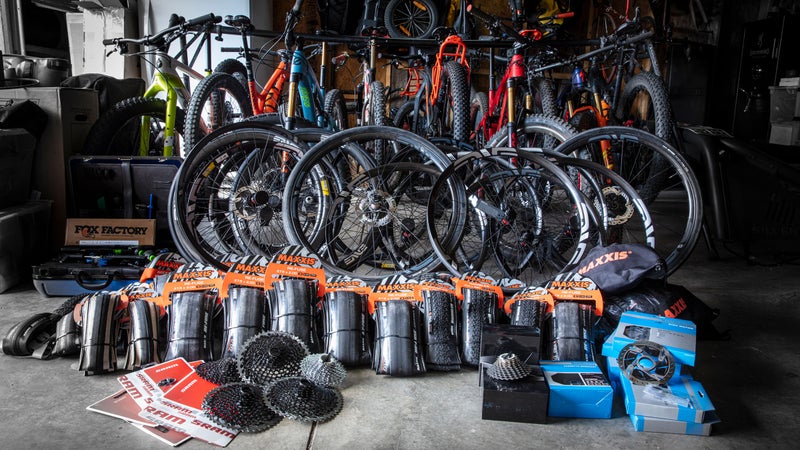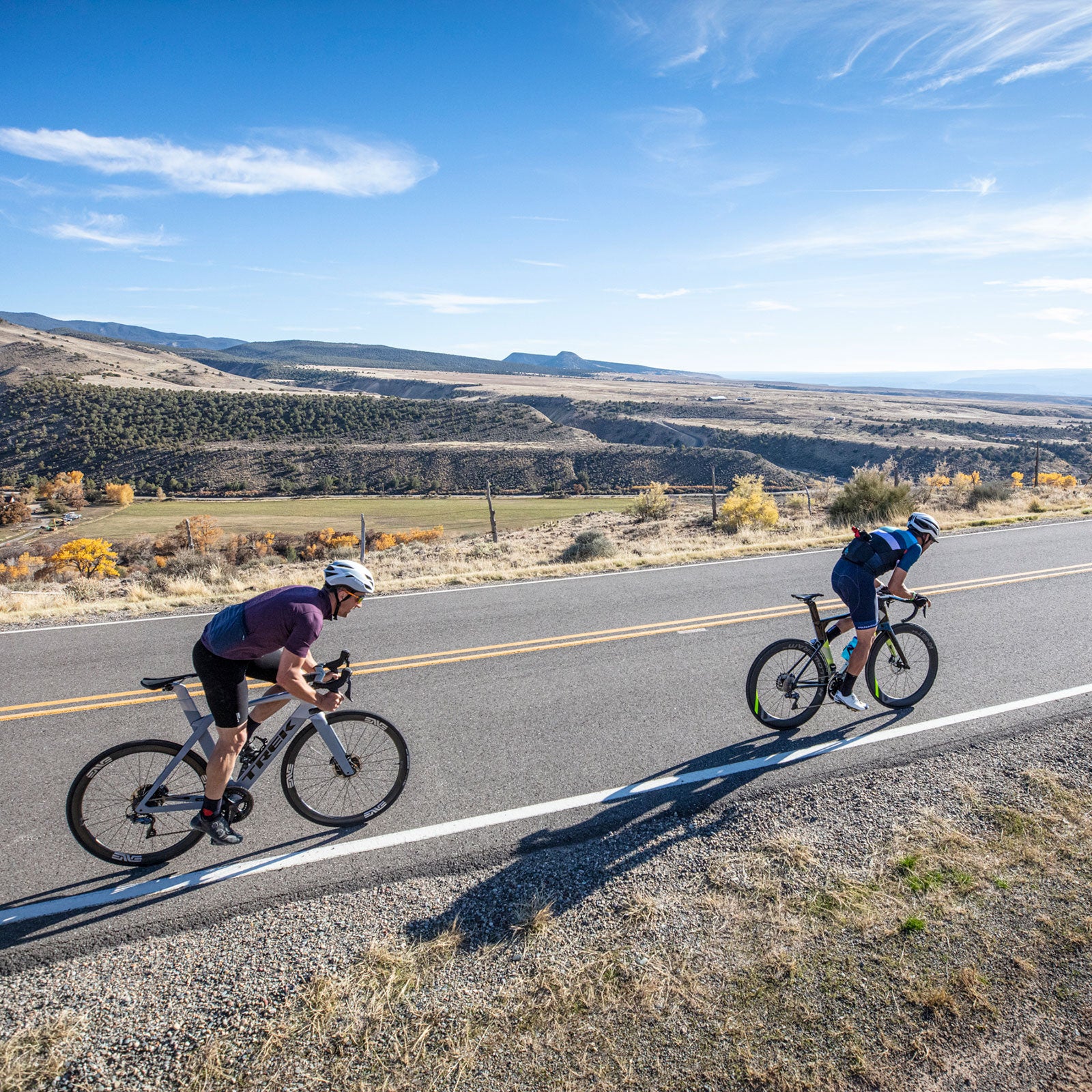IÔÇÖve said it for years, but the single best upgrade you can make to a bicycle is to get better wheels and tires. A pound of weight in the wheels, especially in the rims, makes a far bigger impact on inertia and how a bike feels than the same amount of weight in the frame. Pleasantly stiff wheels can improve steering, tracking, and cornering, while noodly ones make a bike feel listless and unmanageable. And rim widths and shapes, along with well-honed materials, can go a long way to smoothing out the ride. Similarly, quality tires with supple casings also blunt road noise and add traction and confidence. There are a lot of complicated factors and interplay between them, some of which IÔÇÖve written about. But suffice it to say that good wheels and tires are probably the easiest way to palpably boost your bikeÔÇÖs performance.
This truism has implications for our annual testÔÇöheld in Grand Junction, Colorado, in 2018ÔÇöduring which we rode more than 50 of the latest bicycles one after the other to suss out their strengths and weaknesses and determine our favorites. If wheels and tires make such a big difference, then the best way to level the playing field and really compare bikes would be to ride all of them with the same hoops and rubber. WeÔÇÖve known this for a long time (bikes have been eliminated from the test in the past simply because they felt terrible due to cheap and fragile stock setups), but the explosion of hub, brake, and wheel standards always made it impossible to change like setups between bikes. This year, though, thanks to consolidation in the market that has seen disc brakes become the norm on road bikes┬áand Boost spacing with single-chainring┬ádrivetrains saturating┬áthe mountain market, we were finally able to test every bike in the lineup with the same wheels, tires, and pressures. We still rode the bikes as they came, of course, but I had my own set of wheels to sub in and out in order to hopefully isolate the benefits and drawbacks of frame design and suspension.
This was no easy undertaking, given the variety of drivetrains, wheel sizes, and bike styles we test. I settled on Enve as the wheel supplier. The Utah-based company makes some of the highest-quality hoops on the market, and, ergo, theyÔÇÖre expensive. But the strength to weight is superior to most, the workmanship impeccable, the ride quality and durability┬áconsistent across every model, and its customer service (including warranty and crash-replacement programs) is┬áexcellent. I also appreciate that Enve┬áwheels are made in Ogden. Most importantly, the company offered a wide enough breadth of models to meet our needs.
It turned out to be quite an order: for road,  (700c) and (650b) for gravel, 29-inch for cross-country,  in 29 and 27.5 inches for trail and enduro, and in 29 and 27.5 inches for plus bikes. Since I needed doubles of pretty much everything in order to accommodate SRAM and Shimano specs (the two predominant drivetrains), that brought the final tally to 11 wheel sets, which we returned to Enve after the test.

For tires, Maxxis was the natural choice, partly because over years of testing, IÔÇÖve found its rubber to be the most durable across the board for our harsh Southwest-desert environment. But also, it has one of the most diverse offerings of tires, as well as the fullest size range in each style. Road was easy: semi-slick 28c . For gravel I went with the high-volume, low-tread . All of the mountain wheels got one of my favorite aggressive tire setups, a muscly, large-block / combo. The cross-country┬áhoops got low-profile, faster-rolling tiresÔÇö┬áin the front and ┬áin the rearÔÇösince the bigger setup would have been too much. All tires were set up tubeless with , and I ran uniform tire pressures.
Thanks to Maxxis and Enve for supplying the big parts for this trial. Both Shimano and SRAM were also crucial, providing a range of cassettes and rotors to keep switch times minimal.
Before I get to comparative reflections, itÔÇÖs worth dwelling on these products┬áfor a minute. There are many great wheels out there, but EnveÔÇÖs provide an incredibly refined ride consistently across the product line. The 3.4ÔÇÖs feel blazing fast, smooth, and solid; the G Series provides a very forgiving ride on rough terrain; and the M Series is exceptionally light and strong, with wide internals for large tire-contact patches. I was just as impressed with the Maxxis range, most notably the Re-Fuse gravel offering, which provided excellent traction and cut resistance, despite the low-volume tread, as well as a soft, supple feel. And the Minion DHF/DHRII combo provides some of the best grab and hook-up on rocky, loose terrain of anything IÔÇÖve ever ridden. The ultimate testament: in nearly three months of riding these setups last year, I never got a single flat tire.
The best illustration of why comparison testing like this is important came on day one. As an experiment, I rode two gravel bikesÔÇöthe Fuji Jari Carbon 1.1 and the ÔÇöon two laps each, first in their stock configurations, then with my custom wheels. With the stock WTB i23 wheels wrapped in 43c Panaracer GravelKing tires, the Fuji felt quick but a little slippery on the loose stuff┬áand a touch harsh overall. It wasnÔÇÖt my favorite. The Donnelly, on the other hand, came with house-brand Ushuiaia wheels and 40c XÔÇÖPlor MSO tires. And though the bike had nice compliance, the ride was a little muted, soggy even. I probably would have said I preferred the Fuji over the Donnelly. After putting on the Enves mounted with Re-Fuse tires, though, my impressions changed. The Fuji still felt sharp, though not as much, while the Donnelly remained supercomfortable but was far sprightlier. Basically, by eliminating the wheel and tire variance, I realized that I preferred the Donnelly for its suppler ride.
Another example happened┬áa week or so later, when I was riding the Specialized Stumpjumper. I did a lap on Mack Ridge, at Loma, aboard the stock Roval wheels and SpecializedÔÇÖs Butcher/Purgatory tire combo. ItÔÇÖs a rocky, techy, fast descent, and though I loved it, I definitely felt the tires skating in hard corners. The next lap was aboard the same bike with Enve 635ÔÇÖs and the 2.6-inch┬áMaxxis DHF/2.5-inch┬áDHR II combo, and not only did I feel locked in and far more confident, I was more than 20 seconds faster on the five-minute downhill. The wheel and tire choice made me like the bike more than I would have otherwise.
From the outside, this might seem like a lot of process for little return, but I was pretty amazed by what we found. For one thing, itÔÇÖs heartening that, after so many years of varied standards, itÔÇÖs possible to so quickly and easily change wheels between bikes. Of the more than 50 bikes we tested, only a few (think: belt drive, Pinion gearbox, etc.) wouldnÔÇÖt accept the wheels. And I feel like my impressions of this yearÔÇÖs bikes are more accurate than they have ever been. Of course, we took into account stock builds for our end reviews, as thatÔÇÖs the way many people will purchase bikes. But being able to isolate impressions on the frames and suspension systems really allowed us to hone into the nuanced differences between bikes. Perhaps most importantly for the end consumer, switching between average stock wheels and tires and superior ones underscored their importance. If you are after the best ride you can get, put your money into quality wheels and tires above all else.


